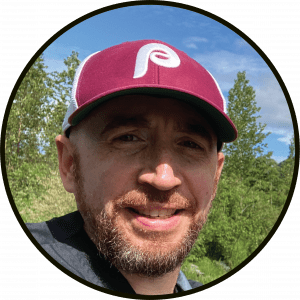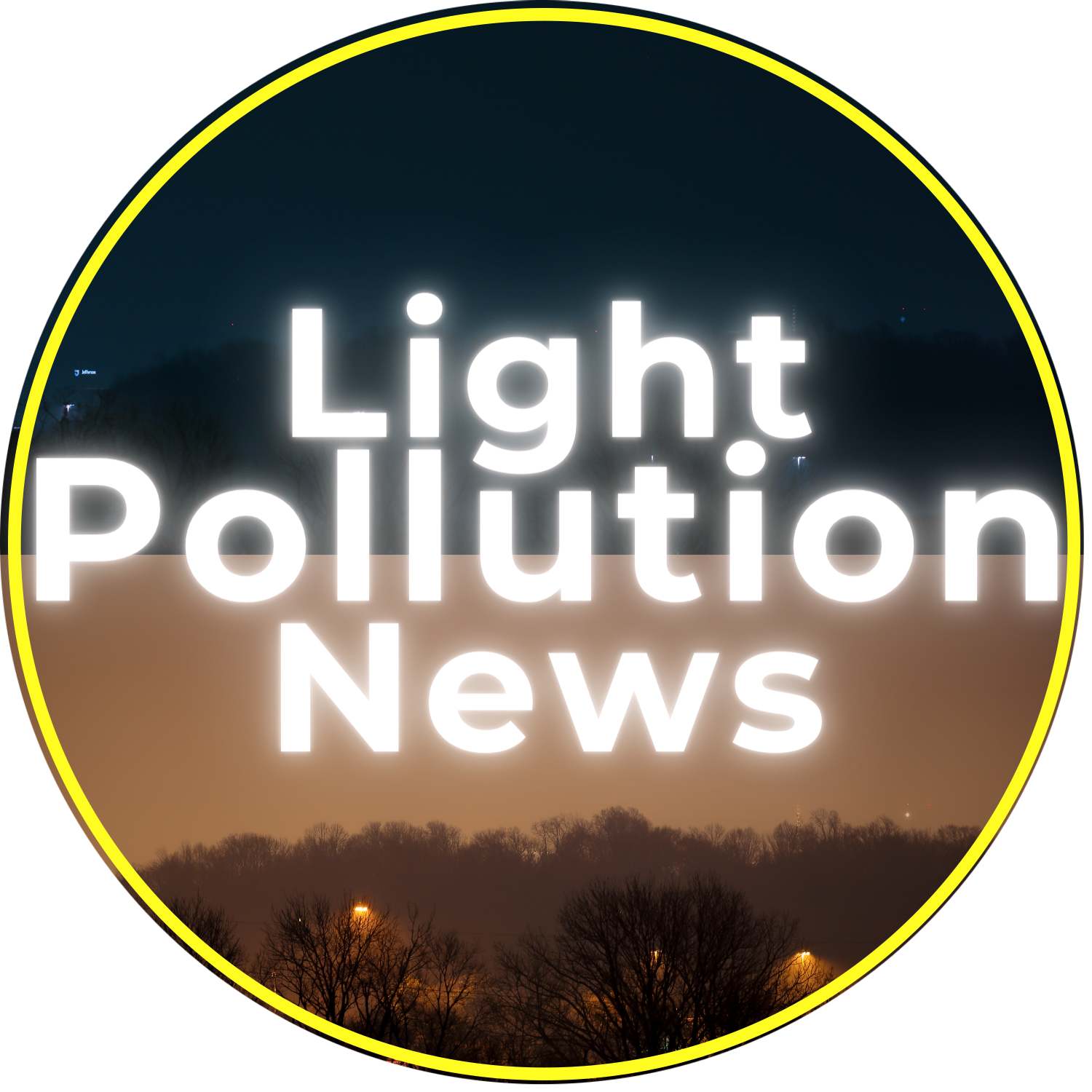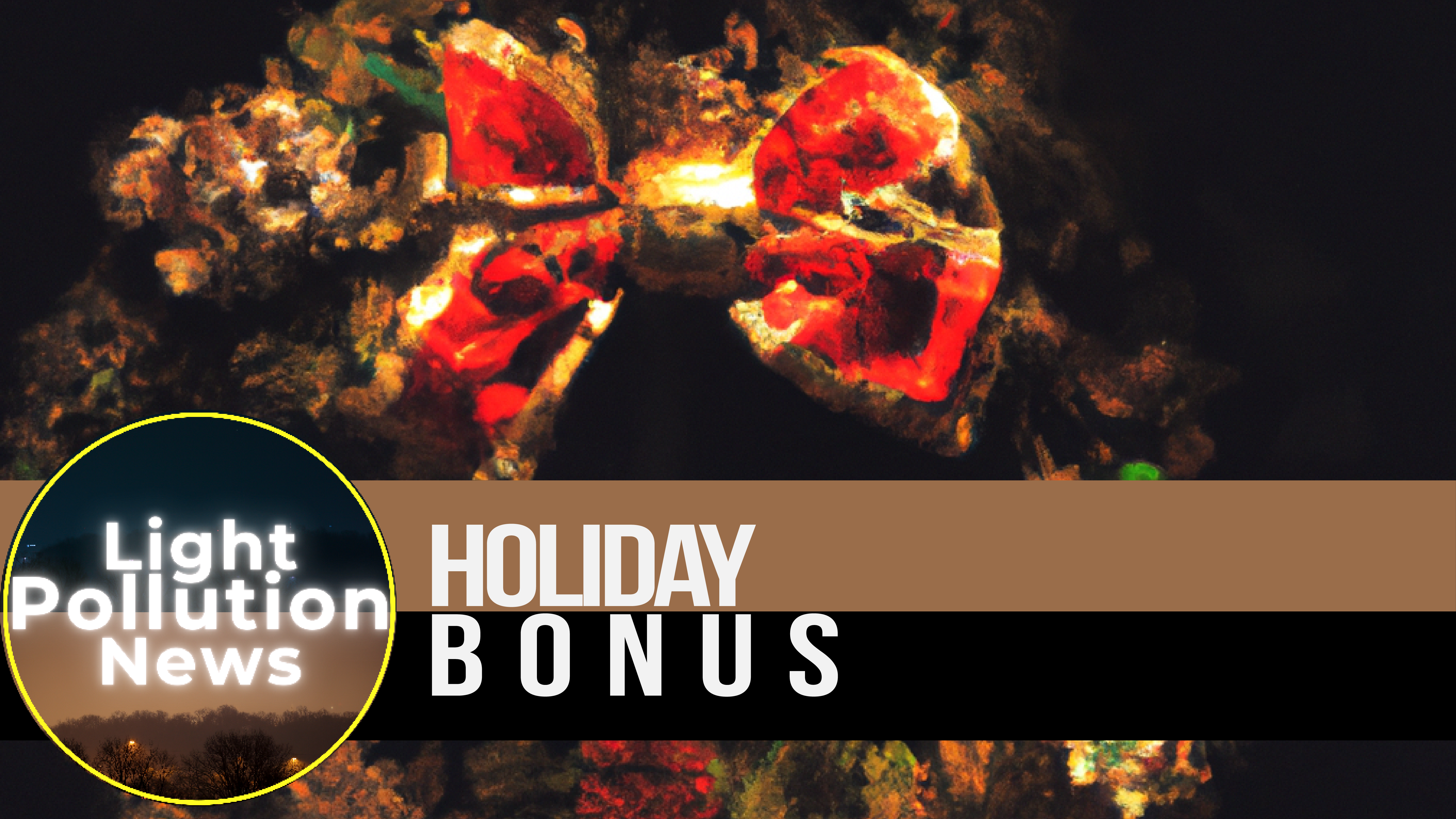
Join the conversation at r/lightpollutionnews or Follow us @Light.Pollution.News or LightPollutionNews. Join our mailing list.

Holiday 2023: Your Holiday Bonus!, Light Pollution News.
Host:

Bill McGeeney
Article List:
- Bored Ape creator says UV lights at ApeFest burned attendees’ eyes and skin, Beth Mole, Ars Technica.
- Lighting up rural Zimbabwe with upcycled plastic and LEDs, Privilege Musvanhiri, Deutsche Welle.
- The night sky is always getting faked, Emma Roth, the Verge.
- Illuminating investments: capitalising on the battle against light pollution, Lombard Odier.
- 12 News Investigates: Hidden neighborhood danger — street lights shocking dogs, killing one, Hillary Mintz, WISN.
- LED lightbulbs may be hazardous to your health, Katherine Drabiak, The Hill.
- Q&A: Why Do Humans Need Dark Skies?, Anya Petrone Slepyan, Daily Yonder.
[Dec]: Bored Ape creator says UV lights at ApeFest burned attendees’ eyes and skin, Beth Mole, Ars Technica.
Are you familiar with the Bored Ape NFT? No? Well the Bored Ape NFTs are probably the most notable of a collectible type crypto investments that peeked during the 2021 NFT craze, with NFT meaning non-fungible tokens.
Apparently, Bored Ape owners join together for an annual meet up called ‘ApeFest.’ This year’s ApeFest, taking place in Hong Kong, left some visitors with a “severe pain and burning sensation in their eyes.” Something akin to snow blindness or welder’s flash!
20 people received what essentially amounted to eye sunburn from a massive amount of UV exposure inside the convention.
In the same month, there was this inspiring piece from Africa.
[Dec] Lighting up rural Zimbabwe with upcycled plastic and LEDs, Privilege Musvanhiri, Deutsche Welle.
Lights do serve a purpose, and nothing better illustrates the need for light at night than this story from Deutsche Well.
A man by the name of Aluwaine Manyonga created a solution for electricity starved rural Zimbabwe.
The Chigubhu lamp upcycles used plastic bottles to essentially become a solar powered LED lantern!
Manyonga scours trash sites to collect containers that he uses to construct the lantern.
He’s already made 500 of such lights which he hands out to school children to help them extend their studies after hours.
Manyonga is working to educate students on how to build their own solar lanterns. The news story spun this piece as a circular economy solution to leverage waste for good.
In April, the Verge had a bone to pick with night sky photographers.
[Apr] The night sky is always getting faked, Emma Roth, the Verge.
Have you ever done this, faked a night sky shot?
People have been faking the nightsky for longer than you think!
Even dating back to the ungodly age of film, Astronomer Tyler Nordgren recalled postcards he saw of the American Southwest which had the moon rising in the wrong location and casting incorrect shadows down onto the subsequent buttes.
This spring, Samsung came out with its new “enhance” feature, essentially a blur corrector, which can add details to things that weren’t apparent the first time around, as was the case when a Reddit user showed a cleaned up version of a previously completely blurred moon photo.
Beyond Samsung, Adobe users have found ways to create further disingenuous touchup adjustments.
One such came from a National Geographic photo published in 2019.
Photographer Beth Moon shot a picture of old trees under an arching milky way. However, a keen observer, or honestly – it’s so obvious, a not so keen one will suffice as well-
-You will note the cloned milky way that stretched in almost copy and paste repetition across the entire night sky.
How about that for some shotty fakery!
With the introduction of ai photo editing software, I can only imagine such fakes will become common place and less identifiable.
Well, in September, I saw this press release.
[Sept] Illuminating investments: capitalising on the battle against light pollution, Lombard Odier.
Investing firm, Lombard Odier, went all in on “restorative” investments, which I presume are targeting responsible practitioners of environmental activities including everything from pest management to heavy industry.
One of the spots they specifically spoke to was “Securing the future of our skies,” which took aim directly at promoting smarter cities to reduce environmental impacts and protect the night skies.
The press release specifically cited the example of Barcelona and the City of London, two communities that were spoke about this year on the show.
You’ll recall that the City of London, a subset community in the greater London area, requires builders to submit plans on light pollution mitigation. And in 2021, Barcelona began using motion detecting lamp posts that dim automatically when no one was present.
As you’re well aware, we have a lot of street lighting stories that end up on the show. If there’s one thing that I can tell you, in 2023, we had our share of strange ones, and more to that point, we had a number of sad ones even! But this one might be the saddest.
[March] 12 News Investigates: Hidden neighborhood danger — street lights shocking dogs, killing one, Hillary Mintz, WISN.
Take this article from March, whereby a street light pole electrocuted a dog when its leash, which had some metal in it, conducted a charge from the pole to the dog.
The city of Milwaukee claims that the short was caused simply by aged infrastructure. That won’t bring back Ted, Erich Gross’s poodle mutt rescue.
Now Gross is on a mission to ensure this problem doesn’t occur again. Gross goes pole to pole testing voltage levels.
This one came in late to my feed but it was a good one.
[Oct] LED lightbulbs may be hazardous to your health, Katherine Drabiak, The Hill.
Back in July, the Biden Administration gave the Energy Department the green light to flick the switch on incandescents and convert everything over to LEDs.
This was largely done due to the vast energy efficiencies realized from LEDs, though the move did have its detractors.
Some of those include a University of South Florida public health professor, Katherine Drabiak.
Following the rule change, Drabiak wrote a detailed piece in the Hill disputing the Biden Administration’s claim that there was “no evidence that using LEDs in daily life directly results I adverse health effects or negatively affects animals.”
Drabiak’s contention cited numerous sources including a report from 2019 for which the French Agency of Food, Environmental, and Occupational Health and Safety identified dangers including LED flicker, “phototoxicity, glare and circadian rhythm impacts.”
If you’ll recall, in our December episode, guest Stephen Hummel’s girlfriend experienced headaches and eye strain from the flicker of LEDs. Some people are simply more susceptible than others.
Drabiak also cites a 2014 study that found blue light in LEDs to “induce damage in retinal cells, which can lead to vision problems, speed up aging of our eyes and lead to macular degeneration.”
You know, I always wondering about eye damage from those super bright LED lights that often are purchased by parking lot, apartment building, and gas station owners. That’s something to pay attention to in coming years.
Lastly, and Drabiak cites several other proofs to further her case, though I found this one to be perhaps the most overlooked.
A 2013 article identified the impact of resource extraction and depletion for LEDs, citing it to have negative environmental impacts of upwards to 3x that of the incandescent bulb. There’s a piece of research that rarely gets bantered around. It will be interesting to see if LED production is reigned in during the coming year.
[Nov] Q&A: Why Do Humans Need Dark Skies?, Anya Petrone Slepyan, Daily Yonder.
Closing out this brief episode, here’s a quote from the Daily Yonder article on October 6th titled “Why Do Humans Need Dark Skies?”
Per New Mexico based park ranger, Peter Lipscomb:
DY: The night sky is very important to you personally — when did you first feel that connection?
PL: So my personal relationship with the night sky began as a young one, as a child growing up in Virginia and being in parts of Virginia that were rural and places that had a dark enough sky. I was just enthralled by what I could see after the sun went down, the twinkling stars and the moon. Things that are available to everybody if they get out to a place that’s naturally dark. So that became a source of fascination and wonder for me. But it all shifted in a really big way when I experienced the total eclipse of the sun on March 7th, 1970, when I was eight years old. And that experience was profound at every sensory level.
I was at the beach. So I felt the breeze freshening and I smelled the ocean, felt the cooling of the air against my skin as the breeze started blowing. I heard the birds quieting as if it was twilight and they were going to roost. And seeing that there are big things happening out there, with the moon moving in front of the sun, I wanted to know more about what those big things were. So at that moment, I began a deeper journey in astronomy, in terms of wanting to learn more about the different phenomena out there and getting a sense of how we fit into the grand cosmos.

